After landing at Windhoek’s International Hosea Kutako Airport, located about 40km outside of Windhoek, and after clearing customs & immigration, you will be welcomed by your Ultimate Guide who will brief you on your day ahead and give you time to ready yourself for the start of the journey. You then depart Windhoek in your safari vehicle with your private guide and drive southwest through the scenic Khomas Hochland highlands before heading down the Great Escarpment into the Namib Desert below, stopping for a picnic lunch at a scenic location along the way. You arrive at Desert Hills Lodge in the midafternoon and you will stay here for two nights whilst you explore the remarkable sights of the Namib Desert with your guide. If there is still time today, your guide will take you to visit Sesriem Canyon, a nearby geological attraction, or explore Elim Dune. However, if you prefer, you can just relax and soak in the scenic and tranquil surroundings at Desert Hills Lodge. The following day you will need to rise early for a magical excursion with your guide in the Namib Naukluft National Park, normally setting off before sunrise to enter the park at sunrise and capture the dunes whilst the light is soft and shadows accentuate the towering shapes and curves. This area boasts some of the highest free-standing sand dunes in the world and your guide will give you an insight on the formation of the Namib Desert and its myriad of fascinating creatures and plants that have adapted to survive these harsh environs. Once you have explored Sossusvlei, Deadvlei and surrounding dune fields to your heart’s content you can enjoy a relaxed picnic brunch in the shade of a camel thorn tree. You then return to Desert Hills Lodge in the early afternoon in time for a late lunch, with the option to visit Sesriem Canyon afterwards if you haven’t already done so the day before. The rest of the afternoon is at leisure.
The Namib is a coastal desert that consists of dune fields, gravel plains and bare rock. The only true desert in Africa south of the equator, the Namib lies largely within Namibia, along the south-eastern shoreline of the Atlantic Ocean. In the south it extends into South Africa, across the Orange River, while in the north it crosses the Kunene River into Angola. Three-quarters of it falls within Namibia, where it covers nearly a fifth of the country, an area four times the size of Switzerland. With a coastline of 1 570 km, the Namib Desert occupies the western margin of the country in its entirety, from the ocean to the Great Escarpment. Arid on the whole for the past 15 million years, the Namib is a desert on top of a desert, with petrified dunes buried beneath active sands. As such it is widely held to be the oldest desert on earth. The present day surface sands formed after the cold Benguela Current began to flow offshore, but its physical boundaries, the ocean and the escarpment, are very much older. The Namib Sand Sea is created by sediments washed down the Orange River to the Atlantic, where the Benguela Current sweeps it northwards and dumps it onshore. Finally, onshore winds drive the sand inland to form dunes of all shapes and sizes. The sand consists largely of quartz grains with patches of heavy minerals such as garnet, ilmenite and magnetite as well as a little mica darkening the dunes. The colour of the quartz grains darkens from pale buff in the west to deep red in the east as the iron-oxide content of the sand increases. Between the seaside towns of Walvis Bay and Luderitz, the Namib Sand Sea is greater in size than Israel and Lebanon combined. It is filled with dunes and is virtually impenetrable except along its fringes, for example where the Tsauchab River carves a valley to Sossusvlei. Sesriem Canyon has evolved through centuries of erosion by the Tsauchab River which has incised a narrow gorge about 1.5 km long and 30 meters deep into the surrounding conglomerates, exposing the varying layers of sedimentation deposited over millions of years. The shaded cool depths of the canyon allow pools of water to gather during the rainy season and remain for much of the year round. These pools were a vital source of water for early settlers who drew water for their livestock by knotting six (ses) lengths of rawhide thongs (riems) together, hence the canyon and surrounding area became known as Sesriem.
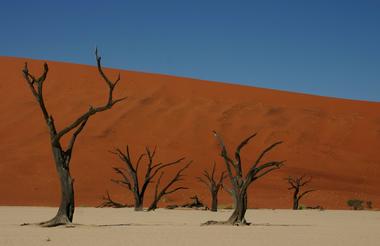
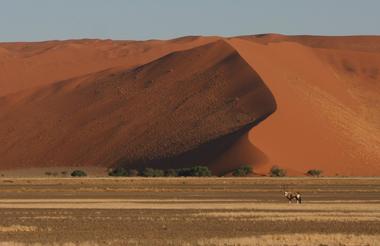
NOTE: Option to include a sunrise balloon flight before you depart for Swakopmund (optional extra at additional cost). Please note that if making use of this offer, it will need to be booked exclusively with Ultimate Safaris in order to fit in with other timings for this day.
The fascinating drive today takes you northwest through awesome and ever changing desert landscapes of the Namib Naukluft National Park, including the impressive Gaub and Kuiseb canyons. You will meet the coast at the port town of Walvis Bay and then continue north to Swakopmund where you can enjoy the pleasant seaside location and cooler coastal air for your next two nights. There will be time this afternoon to explore the town and wander along the waterfront on foot, before heading off for dinner at a popular restaurant which specializes in locally harvested seafood. The following day is free to enjoy exploring in and around Swakopmund and Walvis Bay - there are many optional activities (for additional cost) available including: catamaran dolphin and seal cruises, sea kayaking, sand-boarding, fat-bike excursions, birding tours and scenic flights over the Skeleton Coast.
NOTE: As an alternative to the drive from Dead Valley Lodge to Swakopmund you may like to take a scenic light aircraft flight over Sossusvlei and along the Diamond Coast (optional extra at additional cost), allowing you a bird’s eye view over the dune sea, abandoned mining camps, shipwrecks, Sandwich Harbour and salt pans before you land at Swakopmund Airport. Your guide will drive to meet up with you in Swakopmund later in the day.

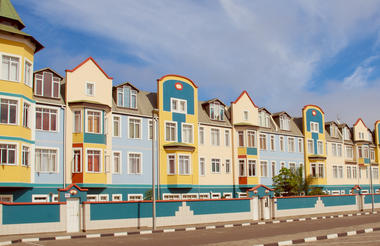
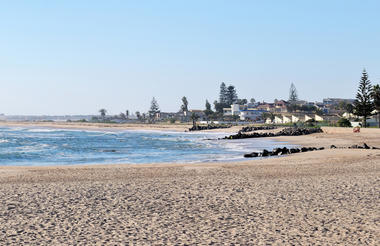
Continuing on your safari today, the road takes you north and east into the wonderful and diverse region of Damaraland. You pass Namibia’s highest mountain, the Brandberg which peaks at 2,573 m above sea level, and take time to absorb the vastness of the scenery along the way. Damaraland is typified by displays of colour, magnificent table topped mountains, rock formations and bizarre-looking vegetation. The present day landscape has been formed by the erosion of wind, water and geological forces which have formed rolling hills, dunes, gravel plains and ancient river terraces. It is the variety and loneliness of the area as well as the scenic splendour which will reward and astound you, giving one an authentic understanding of the word 'wilderness'. If time allows this afternoon your guide will take you to visit the nearby attractions and geological sites of the pre-historic Twyfelfontein rock engravings (a UNESCO World Heritage Site) - if not there is plenty of time to see them the following day.
Your full day at Camp Kipwe sees you partaking in an early breakfast before heading out on an exciting 4x4 excursion along the ephemeral Aba Huab and Huab River valleys to explore this remarkable region and to search for game, including the elusive desert adapted elephants if they are in the area. Damaraland is home to a variety of desert adapted wildlife and hidden desert treasures. As the elephants are mostly active in the mornings you will normally have the best chance to see them then before returning to camp for lunch. However, if all the safari participants agree, you also have the option to take a picnic lunch and stop to enjoy that in the shade of a large Ana tree by the riverbed, ideally while watching a herd of elephant browsing nearby. Your guide will arrange to fit in a visit to Twyfelfontein and other nearby attractions at a suitable time if you haven’t already done so the previous day. On return to camp there should be time to take a walk into the local area with your guide if desired, or simply relax and enjoy some well-deserved leisure time.
Twyfelfontein: Strewn over a hillside amongst flat-topped mountains of red sandstone, Twyfelfontein’s boulders and slabs of red sandstone hold some 2,500 prehistoric engravings that depict wildlife, animal spoor and abstract motifs. It is perhaps the largest and finest collection of petroglyphs in Africa. The engravings show animals such as elephant, giraffe, kudu, lion, rhinoceros, springbok, zebra and ostrich that once used to drink from a fountain at the bottom of the hill. In some cases footprints were engraved instead of hooves or paws. The abstract motifs feature mainly circles. Stone tools and other artifacts found at Twyfelfontein suggest that hunter-gatherers occupied the site over a period of perhaps 7,000 years. These days a local guide accompanies visitors to showcase the rock art. The engravings lie along two circular routes, one an hour’s climb and the other 40 minutes longer. Twyfelfontein is one of Namibia’s key National Monuments and is a UNESCO World Heritage Site.
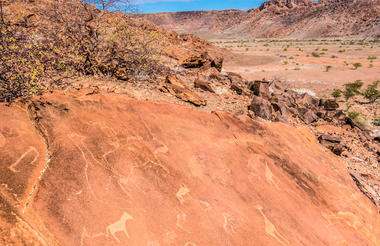
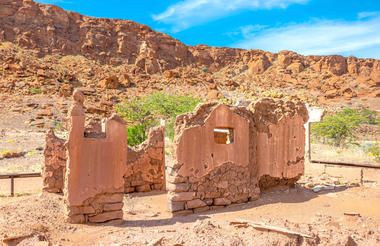
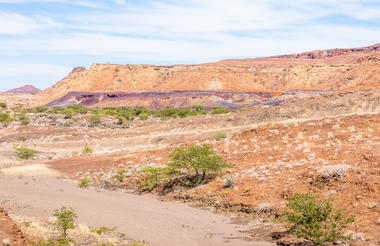
Today you set off on your journey to the Ongava Tented Camp, which is situated on the south western border of Etosha National Park on the Ongava Game Reserve. You arrive in time for an afternoon game drive on the Reserve in an open game viewer with an Ongava ranger, on shared basis with other lodge guests
Your full day at Ongava sees you heading into the southern-central section of Etosha National Park with your private safari guide. You make your way from the southern Andersson’s Gate via selected waterholes - staying in the park for the whole day or returning to camp in time for lunch and re-enter in the afternoon. The rest of the evening can be spent game viewing at the camp’s floodlit waterhole where game comes and goes throughout the day and night
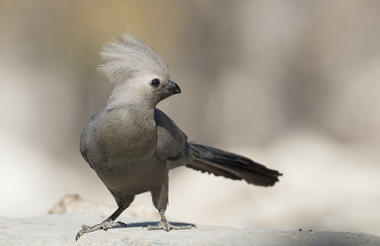
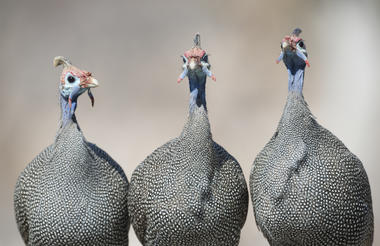
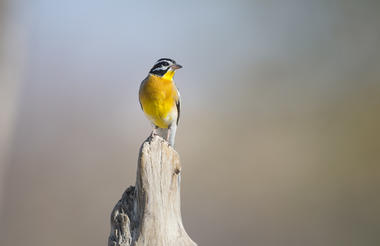
Your early departure will take you south from Ongava Tented Camp via Outjo, Otjiwarongo and Okahandja to reach Windhoek International Airport in time to check in for your ongoing international flight.
 (1) (002)1.png?fmt=png)


 (1) (002)1.png?fmt=png)
